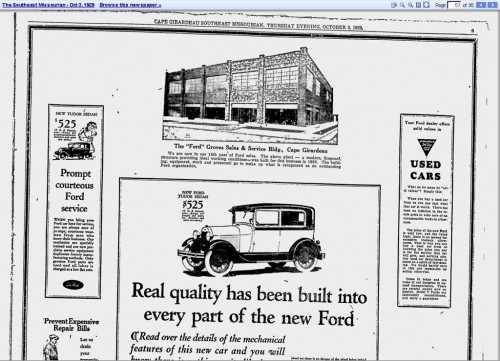 The first gas-powered automobile of record in Cape Girardeau was a Great Northern owned by George McBride, a stave manufacturer. The year was 1904. The Missourian’s 25th Anniversary edition has a fascinating history of the automobile from a 1929 perspective.
The first gas-powered automobile of record in Cape Girardeau was a Great Northern owned by George McBride, a stave manufacturer. The year was 1904. The Missourian’s 25th Anniversary edition has a fascinating history of the automobile from a 1929 perspective.
Other motorists in 1904
Dr. A.D. Blomeyer drove a Locomobile, a slow-moving, steam-powered vehicle.
The first gasoline bus was the “Red Devil,” bought by William Gockel. The paper said that “the Red Devil remained true to its name during the period Mr. Gockel was its owner and he finally gave it away for fear it may take a notion to return to the place from which, as its name indicated, it originally came.”
Buggy manufacturer considers Cape
Not everyone was so sure automobiles were going to be a permanent transportation fixture. Russell Gardner, a prominent St. Louis buggy manufacturer, came to Cape in October, 1904, to select a location for a buggy factory that was to be in operation by March of the next year. The factory was never built.
Cape automotive pioneers
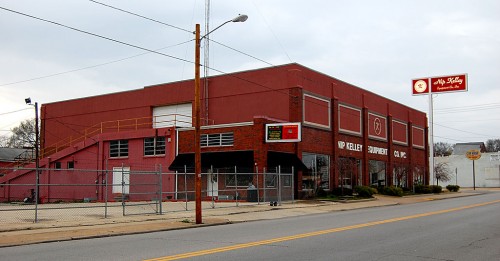
Fred A. Groves and O.G. Edwards came to Cape in 1914 to start an automobile business. They had been in business together in Farmington, a Missourian story explained, when they decided to give Cape a go.
It took them three days to drive from Farmington to Cape Girardeau. One day from Farmington to Ste. Genevieve; one from Ste. Gen to Perryville, and one to cover the 35 miles from Perryville to Cape.
The two young men established an agency for Hudson and Hupmobile. Edwards went back to Farmington, but Groves stayed in Cape. He took over the Ford agency in 1914. Groves sold 5,526 Ford Model Ts and 500 Model As in his first 15 years.
Other early Cape car dealers
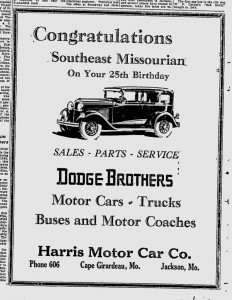 A Dodge franchise went to Thomas L. Harris.
A Dodge franchise went to Thomas L. Harris.- Rudert and Sons started in the garage and automobile agency business in 1917.
- Albert P. Rueseler and Walter Bohnsack organized the Rueseler-Bohnsack Auto Co. in 1923. The Rueseler Motor Co. was formed in 1925, and Bohnsack became a Studebaker dealer.
Significant dates in Cape automotive history
- First car theft: Oct. 21, 1905. Salesman Vince Chapman left his car in front of the Broadway Mercantile Co. “Manufacturers apparently thought there was about as much temptation for the predatory criminal to steal an automobile as to steal a box car or a steamboat and had not provided locks,” The Missourian speculated. There is no indication that the car was recovered. It is estimated that there were perhaps 20 cars in Cape at that time.
- Fastest time Cape to Jackson: July 9, 1906, Joe Wilson drove from Cape to Jackson in a record time of 25 minutes, “probably the shortest time in which the 10 miles had ever been traversed up to that time.”
- First Tin Lizzie: George McBride (remember him) brought the first “Henry” into Cape in May of 1909.
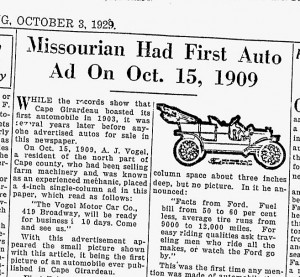 First garage: A.J. Vogel opened the first garage on Jan. 10, 1910. It had a showroom big enough to hold six cars, a washing and cleaning shop and a repair shop. Vogel, a farm machinery salesman and experienced mechanic, placed the first display auto ad to run in The Missourian. The 4-inch, single column ad read: “The Vogel Motor Car Co., 419 Broadway, will be ready for business in 10 days. Come and see us.”
First garage: A.J. Vogel opened the first garage on Jan. 10, 1910. It had a showroom big enough to hold six cars, a washing and cleaning shop and a repair shop. Vogel, a farm machinery salesman and experienced mechanic, placed the first display auto ad to run in The Missourian. The 4-inch, single column ad read: “The Vogel Motor Car Co., 419 Broadway, will be ready for business in 10 days. Come and see us.”- First auto license tax: Dec. 6, 1909. $5.
- First car vs ped: July 21, 1910. Esaw Hendrickson, a Delta farmer, got off a street car between the H&H Building and the Idan-Ha Hotel and stepped in front of a car driven by City Councilman Joe T. Wilson. He was knocked down and run over, but his injuries were not serious.
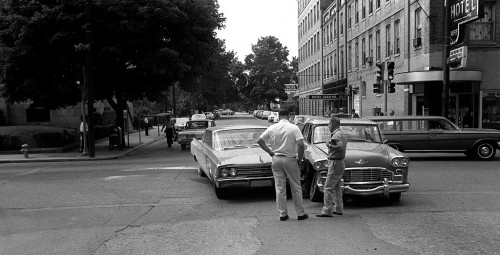 (Cars were still bumping into each other at Broadway and Fountain in 1966. See more photos of this crash, plus read about Fred Kaempher, Cape’s song-writing policeman.)
(Cars were still bumping into each other at Broadway and Fountain in 1966. See more photos of this crash, plus read about Fred Kaempher, Cape’s song-writing policeman.)
- First auto vs bicycle: the day after Mr. Hendrickson’s accident, a car driven by R.B. Oliver, Jr., and a bicycle ridden by Fred Frenzel, a Western Union messenger boy, collided at the corner of Broadway and Spanish. “The boy was not hurt much, but his brand-new wheel was demolished.”
- First funeral procession: Oct. 30, 1916, when the body of Charles E. Booth, a Frisco fireman, was laid to rest. The Brotherhood of Locomotive Firemen and the Odd Fellows asked Booth’s friends to bring automobiles for the funeral procession.
Cars were big business in Cape in ’29
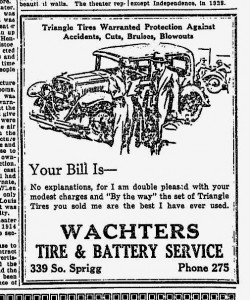 Ten garages were exclusively devoted to repair work; 14 others were dealerships in addition to their garage functions.
Ten garages were exclusively devoted to repair work; 14 others were dealerships in addition to their garage functions.- Two automobile accessory concerns.
- Three automobile battery stations.
- Seven exclusive tire and service stations, not counting garages and stores handling tires.
- One vulcanizing shop.
- At least 30 filling stations.
- Cape automotive landmarks
- First car theft: Oct. 21, 1905. Vince Chapman left the car in front of the Broadway Mercantile Co. “Manufacturers apparently thought there was about as much temptation for the predatory criminal to steal an automobile as to steal a box car or a steamboat and had not provided locks.” There is no indication that the car was recovered. It is estimated that there were perhaps 20 cars in Cape at this time.
- Fastest time Cape to Jackson: July 9, 1906, Joe Wilson drove the 10 miles from Cape to Jackson in a record time of 25 minutes, “probably the shortest time in which had ever been transversed up to that time.”
- First Tin Lizzie: George McBride (remember him) brought the first “Henry” into Cape in May of 1909.
- First garage: A.J. Vogel opened the first garage on Jan. 10, 1910. It had a show room big enough to hold six cars, a washing and cleaning shop and a repair shop.
- First auto license tax: Dec. 6, 1909. $5.
- First Missourian auto ad: Oct. 15, 1909. A.J. Vogel, a farm machinery salesman and experienced mechanic placed a 4-inch single column ad: “The Vogel Motor Car Co., 419 Broadway, will be ready for business in 10 days. Come and see us.”
- First auto crash: July 21, 1910. Esaw Hendrickson, a Delta farmer, got off a street car betwen the H&H Building and the Idan-Ha Hotel and stepped in front of a car driven by City Councilman Joe T. Wilson. He was knocked down and run over, but his injuries were not serious.
- First auto vs bicycle: the day after Mr. Hendrickson’s accident, a car driven by R.B. Oliver, Jr., and a bicycle ridden by Fred Frenzel, a Western Union messenger boy, collided at the corner of Broadway and Spanish. “The boy was not hurt much, but his brand-new wheel was demolished.”
- First funeral procession: Oct. 30, 1916, when the body of Charles E. Booth, a Frisco fireman, was laid to rest. The Brotherhood of Locomotive Firemen and the Odd Fellows asked Booth’s friends to bring automobiles for the funeral procession.
